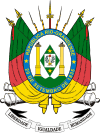Riograndense Republic
| Riograndense Republic | ||||||
| República Rio-Grandense | ||||||
| Unrecognized state | ||||||
| ||||||
| ||||||
| Motto Liberdade, Igualdade, Humanidade (Portuguese for "Liberty, Equality, Humanity") | ||||||
 | ||||||
| Capital | Piratini | |||||
| Languages | Portuguese | |||||
| Government | Republic | |||||
| President | Bento Gonçalves da Silva | |||||
| History | ||||||
| - | Battle of Seival | September 11, 1836 | ||||
| - | Ponche Verde Treaty | March 5, 1845 | ||||

The Riograndense Republic,[1] often called Piratini Republic (Portuguese: República Rio-Grandense or República do Piratini), was a de facto state that existed between September 11, 1836 and March 1, 1845 roughly coinciding with the present state of Rio Grande do Sul, in Brazil. Although never recognised as a self-governing state, it voted itself a Constitution in 1843. It was recognized only by Uruguay.
Independence was proclaimed by Antônio de Souza Neto, who assigned Bento Gonçalves da Silva as its first president during the rebellion which became the Ragamuffin War.
In 1839, the Piratini Republic formed a confederation with the short-lived Juliana Republic (República Juliana in Portuguese) which proclaimed its independence in the same year. November 1839, however, saw the war result in the defeat and disappearance of the Juliana Republic.
The Riograndense Republic had five capitals during its nearly nine years of existence: the cities of Piratini (for which it is often called Piratini Republic), Alegrete, Caçapava do Sul (official capitals), Bagé (for only two weeks), and São Borja. The war between the Gaúchos and the Brazilian Empire was ended by the Ponche Verde Treaty.
Notes
- ↑ "Constitution of the Rio-Grandense Republic (dated 1843)". pampalivre.info. Retrieved 1 September 2012.
References
- Varela, Alfredo. História da Grande Revolução. 6v. Ed. Instituto Histórico e Geográfico do Rio Grande do Sul. Porto Alegre, 1933. http://www.pampalivre.info/alfredovarela/historia_da_grande_revolucao__alfredo_varela.htm (Portuguese)
- http://www.brazil.org.uk/events/machadodeassis_assets/openingaddressvilaca.pdf – Opening address of Dr Marcos Vinicius Vilaça, President of the Brazilian Academy of Letters.

